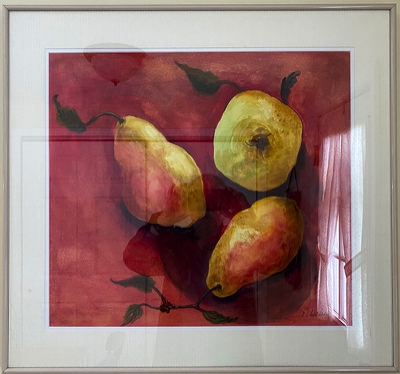
On Outgassing
what it is, prevention and fix-it

An issue that needs discussion, in spite of the fact that, in the end, it is only a minor frustration and does no real harm or damage. I can’t count the number of artists who advise to “just don’t go there” – shut up and refrain from calling attention to the issue. Now, does that sound like me? The long answer is below, the short of it: just clean the inside of the glass at some point down the road.
Spotting Outgassing…
The overall effect is that your prized art work begins to lose its luster. Contrast is reduced, so is clarity. Duh, there’s a film on the inside of the glass. The way to spot it – if it's really bad – is to shine a light on the art and then view from a sharp angle. You will be able to see both the film on the glass and the slight shadow cast from the partially blocked light. It often creates a pattern matching the darker areas of the work. Then again, after a certain amount of time, just assume that it is there.
What is It…
Most art mediums, as they age, give off gasses. Some more than others. Modern giclee print inks, especially the archival kind that contain solid pigment. They release these gasses much more slowly, at a hard to predict pace depending on environment. While all inks contribute, nothing seems to come up to the level of the black inks – and I work exclusively in B&W. Long before I could find discussions on the internet about the subject, I was scratching my head and experimenting, looking for a preventative – as above, the cure is easy.
Solution…
If outgassing occurs, it is easily remedied. Simply remove the work from the frame long enough to clean the inside surface of the glass. You will be amazed at how much better your prized work of art looks.
Our Experience…
Recently we decided that it was time to tackle those pieces in our considerable collection of local art that are sealed behind gless – anywhere from five to twenty five years old. A little daunting in that most artists seal the backs with brown paper. Arrgh. Our conclusion at the end: ALL art work Outgasses, it's just a matter of degree. Even when you can't detect it, cleaning the inside surface of the glass improves the clarity and contrast of the original work.
A couple of works stood out. While watercolors, on the whole, presented a little less of an issue, while one particular large piece was one of the worst culprits – Pears by Nancy Welsh. It's one of our favoriet paintings and hangs in the kitchen. Wow, after about fifteen years the film was very heavy. The painting took on considerable new life with the cleaning. All of our Laura Swallwell feather-paintings were really bad – something we had not really noticed at all. All of this happened so slowly over the years that we never noticed it – the work simply ceased to seem quite as striking, someting that can be easily attributed to some loss of appreciation. This thankfully proved not to be the case.
Of course, none of these were all that easily taken apart and reassembled. Oh well.
Prevention…
… ah, there’s the rub. Especially since outgassing can occur in stages, as well as be aggravated by environmental factors. Trapped glycol gasses seem to have a mind of their own as to when they will escape and find a new home attached to the inside surface of your glass. I divide the potential for outgassing into three stages: short and long term vulnerability. The eternal optimist, I am aggressive in my handling of this issue.
Short term outgassing…
Vulnerable art here would be photography, collages, heavy watercolors, etc. It can show up anytime within a month, depending on temperature, humidity and how long it sat around before being locked up behind glass. It’s very easy, if not a little of a pain in the proverbial katokus and not always doable, to prevent short-term outgassing. Finished work should simply not be framed immediately. It is advised that, if you must frame immediately, that you place sheets of paper over your art to draw out the gasses – and wait at least 48 hours. I like to do this for about a week, then air out the work for another week or more before putting behind glass – the longer the better.
Longer term outgassing…
Outgassing can wait as long as two years to show up. I’ve had the same prints that showed evidence of “short term” gasses, where the glass was cleaned, have to be taken apart again after a couple of years. This was before I, or anyone else, knew there was a problem. No matter how many precautions you take, some gasses remain trapped that can leak out. This is why I maximize my chances with extra precautions in the beginning. I have many a framed image that showed no detectable outgassing whatsoever over a five or six year period – at least to the eye. At the same time the image looked better once the glass was cleaned.
Longterm outgassing is an issue with all art behing glass, whatever the medium. It's simply a matter of motivating oneself enough to tackle the job – especially if, like us, your home is loaded with not only one's own pieces stacked in the studio, but walls full of collected works from other artists.
Our rather large Nancy Welsh watercolor: Pears. After about ten years it was looking a little less dramatic. Turned out it had heavy outgassing accumulation on the inside of the glass.
Here restored and complete with reflections and my shadow in the bottom center…